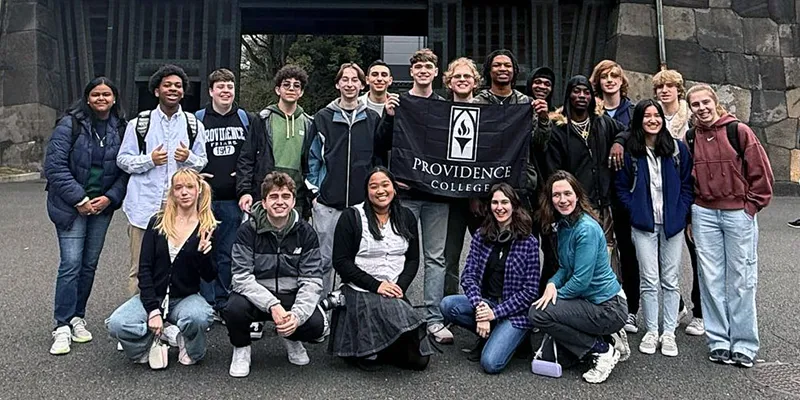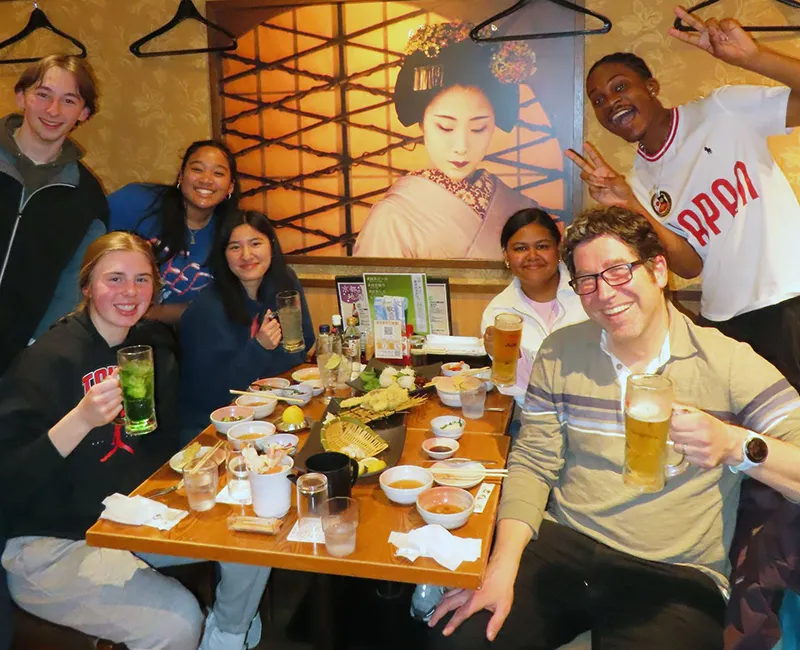March 27, 2025
Students traveled to Tokyo, Hiroshima, and Kyoto on spring break course trip
By Martha Young
Students in Providence College’s Modern Japan course traveled farther than most for spring break, journeying across the Pacific Ocean to centers of Japanese history and culture.
Led by Colin Jaundrill, Ph.D., associate professor and chair of the Department of History and Classics, 20 students — many of whom are in their first or second year at PC — embarked on a weeklong trek across Japan, blending cultural encounters with learning experiences. Jaundrill crafted the trip to include both structured tours and time for free exploration.

The trip began in Tokyo, where students experienced the fusion of tradition and modernity in the city’s skyscrapers, shrines, palaces, and museums. Guided tours included the Asakusa neighborhood, the Imperial Palace, and Meiji Shrine. Students also had opportunities to explore the bustling neighborhoods of Shibuya and Harajuku.
From Tokyo, the group traveled by train to Hiroshima to visit the Atomic Bomb Dome and Peace Memorial Museum, where the first atomic bomb used in war detonated over the city in August 1945. Thatiana So ’27, an accountancy major and Asian and Asian American Studies minor from West Kingston, Rhode Island, called those historic landmarks a highlight of her trip.
“The museum’s collection of artifacts, images, and firsthand accounts provided a vivid depiction of a tragic past,” she said. “Walking through these sites, I was struck by the resilience of those who endured such a terrible time in history.”
Given the weightiness of Japan’s memorial museums, Jaundrill said it was important to provide opportunities for his students to enjoy lighter activities, such as a cooking demonstration in which students learned to prepare Hiroshima-style okonomiyaki — a kind of cabbage pancake.
Mary Rose Comerford ’26, of Portsmouth, Rhode Island, who is majoring in history and minoring in Asian and Asian American studies and business and innovation, reflected on ways the trip shaped her understanding of topics discussed in Jaundrill’s classroom.
“I carried what I’ve learned in class into the museums and shrines we visited. We’ve studied the modernization of Japan, so it was interesting to see cities like Tokyo and Hiroshima and compare them to cities in the United States,” she said.
“Visiting the cities helped me better understand the culture of Japan, including how people dress, etiquette on public transport, and restaurant practices,” Comerford said. Performing karaoke with classmates during a late-night outing is among her favorite memories.
“Karaoke is such a large part of Japanese culture,” she said. “It was fun to experience firsthand.”

The last leg of the trip to Kyoto included guided tours of shrines, temples, and castles, including Nijo Castle, Kiyomizu Temple, and the Golden and Silver Pavilions.
“This trip was a perfect way to expand my education abroad,” said So. “Visiting Japan has always been on my bucket list, and this trip offered so many opportunities to experience its rich cultural heritage.”
For Jaundrill, who started studying Japanese as a teenager and spent three years in Japan between his undergraduate and graduate studies, the trip was an opportunity to introduce students to a culture to which they’re unaccustomed.
“By visiting Japan, students understand how big the world is, and that’s much easier to learn through personal experience,” he said. “Seeing students engage with Japan in real time — asking questions, making connections, and reflecting through daily journaling — was incredibly rewarding. It’s these moments that bring history and culture to life.”





